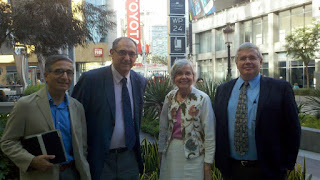"Surgeon infected patients during heart procedure, Cedars-Sinai admits"
When I read this LA Times article, I thought of my husband's three open heart surgeries - two of them for the aortic valve, one for the aorta. I thought of the many others I know who have had aortic valve surgery and some who have had mitral valve procedures. And I thought of the many of all ages who look forward to heart valve surgery one day to extend their lives. When their heart valves fail them, surgery is not just an option, it is their only hope for continued life. What if the seeds of infection remain behind, inside their hearts, after surgery?
What Can Be Done to Avoid This?
What would it be like to go through this major surgery, begin the road to recovery, and then have the newly implanted valve and surrounding tissue attacked by a life-threatening infection? It is a road that no one would ever choose to travel. What can be done to avoid it?
Three things were mentioned in the LA Times article:
There is a great deal of "sewing" around the valve that is necessary to anchor it securely, without leaks. That is the nature of the surgery. Given that, what can an informed patient do to increase their safety?
- the "nature" of valve replacements
- micro tears in the gloves
- inflammation on the surgeon's hand.
There is a great deal of "sewing" around the valve that is necessary to anchor it securely, without leaks. That is the nature of the surgery. Given that, what can an informed patient do to increase their safety?
Micro Tears in Gloves
Quoting the LA Times article linked above, " ...they made a surprising discovery: microscopic tears in the gloves typically worn by surgeons after performing valve replacement surgery. "
Others have investigated tears in gloves, which are important to protect the patient and also the surgeon. This paper from Germany about micro tears in gloves was published in 2010 in the the American Journal of Infection Control.
Concentration of bacteria passing through puncture holes in surgical gloves.
Please note that these surgeries were laparotomies (abdominal surgeries), not heart surgeries. The authors noted that micro perforations went unnoticed by the surgery team 82% of the time.
A previous blog touched on the importance of the surgeon's hands, raising awareness of the importance of the surgeon's skill
"In Our Hands" - Outcomes of Surgery.
Here, we raise awareness of the importance of something that began long ago with Lister - prevention of infection.
The LA Times article further reports that "All surgeons doing valve replacements are now required to change gloves more frequently, officials said. Some surgeons are wearing double gloves during the operations, Sax said."
Asking Questions, Making Decisions
In raising awareness of what happened to these five people, others can learn from it and discuss important questions with their surgeon. Questions about the risk of infection.
- What does the surgeon, and the hospital in which he operates, do to prevent infection?
- If you are having heart valve surgery, do you know how often your surgeon changes gloves?
- Are double gloves used? Why or why not?
- Would the surgeon operate with an "inflammation" on his hands? How are such decisions made?
There is no substitute for being an informed patient.
It is an important part of creating,
and living, in a climate of hope.
Best wishes,
Arlys Velebir
Bicuspid Aortic Foundation






.JPG)





.JPG)



